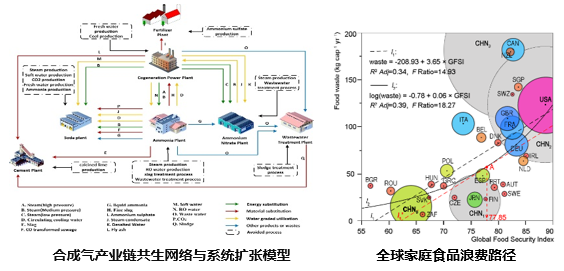
工业生态与系统工程研究室主要研究方向为环境规划与评价、环境系统工程、环境政策与管理、遥感与GIS应用。目前开展的研究工作包括:环境影响评价、生态工业园规划与评价、生命周期评价、清洁生产、食品-能源-水耦合、海域规划与污染预测以及工业过程优化。研究室现有教授1人、副教授5人、讲师1人。
研究组近年来承担《纺织印染集中区节水减排技术集成》、《突发性大气污染事件风险防范与应急技术》、《溢油污染应急处置技术筛选与评估研究》、《国家生态廊道规划与设计》、《区域突发环境事件风险分析与应对策》等国家重大专项、国家“863”课题、国家自然基金项目以及国家环境保护公益项目;完成《大连市地下水基础环境现状调查评估》、《大连西中岛工业气体项目环境影响评价》等多项环保咨询项目。
The Laboratory of Environmental Planning and Assessment mainly aims at environmental impact assessment, environmental systems engineering, environmental policy and management, application of GIS & remote sensing. The current major research and development fields include environmental impact assessment, eco-industrial park planning and assessment, life cycle assessment, clean production audit, food-energy-water nexus, industrial process optimization, and marine management. The laboratory now has 1 professors, 5 associate professors, and 1 lecturers.
In recent years, the group has undertaken several Projects supported by the National Science Foundation, Technology Major Project, and National Environmental Protection Public Welfare Project, including “Water-saving and emission reduction technology integration in textile printing & dyeing concentrated areas”, “Risk prevention and emergency technology for air pollution incidents”, “Evaluation of Oil Spill Pollution Emergency Treatment Technology”, “National eco-corridor planning”. Moreover, consulting projects, such as groundwater survey in Dalian, and environmental impact assessment of Industrial Gas Project in Dalian Xizhongdao were completed during the past several years.
代表性成果
——清洁生产和最佳可行清洁生产技术
通过构建工业生产过程的产品(废物)代谢模型、清洁生产评价指标体系以及生命周期评价,研究企业层次、园区层次工业系统环境问题诊断和工业园区规划技术,揭示重污染行业的生态耗竭和生态滞留机理;以节能、降耗、减污、增效为目标,研究和筛选重点行业源头与过程控制、末端治理和循环利用清洁生产技术。

——中国食品-能源-水系统耦合
系统研究我国食品的可持续消费。具体包括:量化中国居民家庭食品的消费/浪费量及潜在的碳-水-生态足迹,分析食品消费/浪费结构的地理差异,研发贝叶斯模型揭示食品浪费的影响机制;比较在家和在外就餐对供应链碳排放和水资源消耗的影响,揭示外出就餐的动力机制;通过不确定性优化得到健康且可持续的膳食结构。
代表论文
1.Hou H.C.; Shao S.; Zhang Y.; et al. Life cycle assessment of Sea cucumber production: A case study, China[J]. Journal of Cleaner Production. 2019, 213: 158-164.
2.Qi Y.; Zhang Y.; Jiang H.; et al. Life cycle assessment in urban territories: a case study of Dalian city, China[J]. The international journal of Life Cycle Assessment. 2019, 24: 1194-1208.
3.Qi Y.; Zhang Y.; Jiang H.; et al. Life cycle assessment in urban territories: a case study of Dalian city, China[J]. The International Journal of Life Cycle Assessment, 2019, 24: 1194-1208.
4.Hou H.C.; Shao S.; Zhang Y.; et al. Cleaner Production assessment for sea cucumber aquaculture: methodology and case studies in Dalian, China[J]. Clean Technologies and Environmental Policy. 2019, In Press. doi: 10.1007/s10098-019-01746-5.
5.Zhang Y.; Jiang H.; Li J.H.; et al. Life cycle assessment and optimization analysis of different LNG usage scenarios[J]. The international journal of Life Cycle Assessment. 2018, 23: 1218–1227.
6.Ji N.N.; Zhang Y.; Zhang S. S.; Chen Y. Evaluation on the risk controlling value of urban soil organic pollutants based on land-use planning in China [J]. Environ Geochem Health, 2019, doi:10.1007/s10653-019-00287-6.
7.Song G.B.; Gao X.B.; Fullana-i-Palmer P.; et al. Shift from feeding to sustainably nourishing urban China: A crossing-disciplinary methodology for global environment-food-health nexus [J]. Science of the Total Environment, 2019, 647: 716-724.
8.Song G.B.; Han Y.M.; Li J.J.; et al. The potential water-food-health nexus in urban China: A comparative study on dietary changes at home and away from home [J]. Science of the Total Environment, 2019, 657: 1173-1182.
9.Li J.J.; Song G.B.; Semakula H. M.; et al. Climatic burden of eating at home against away-from-home: A novel Bayesian Belief Network model for the mechanism of eating-out in urban China [J]. Science of the Total Environment. 2019, 650: 224-232.
10.Song G.B.; Semakula H. M.; Fullana-i-Palmer P. Chinese household food waste and its’ climatic burden driven by urbanization: A Bayesian Belief Network modelling for reduction possibilities in the context of global efforts [J]. Journal of Cleaner Production. 2018, 220: 916-924.